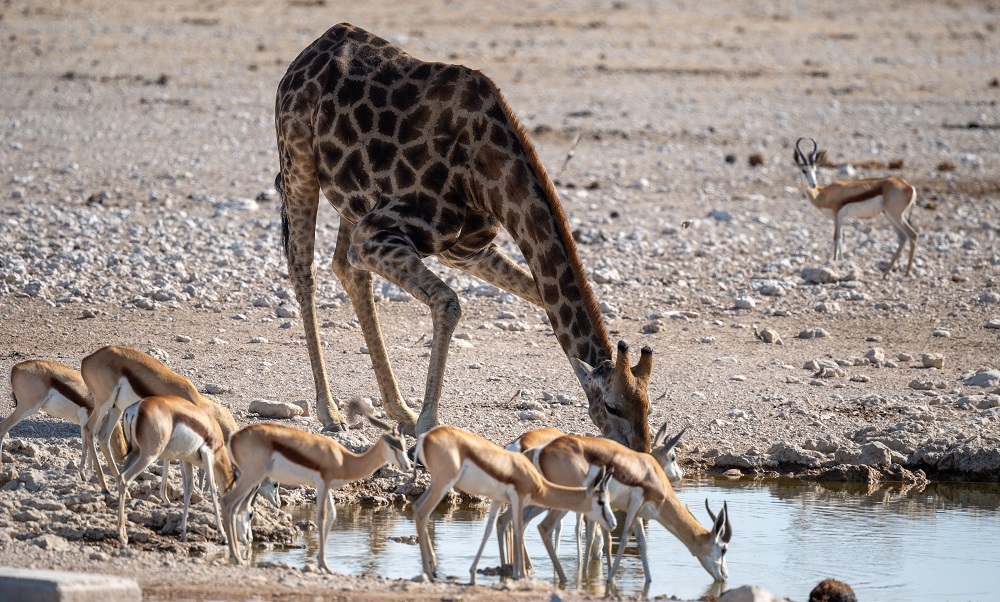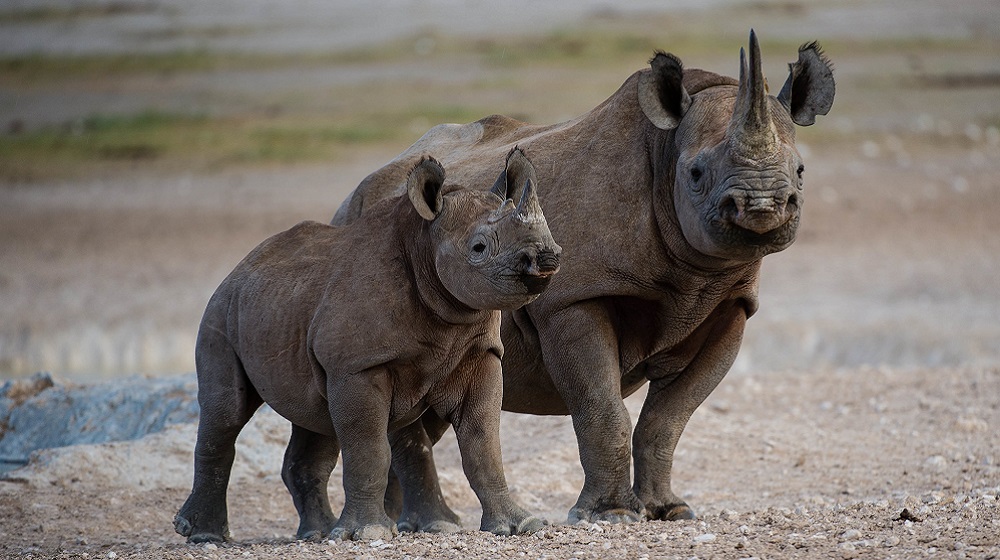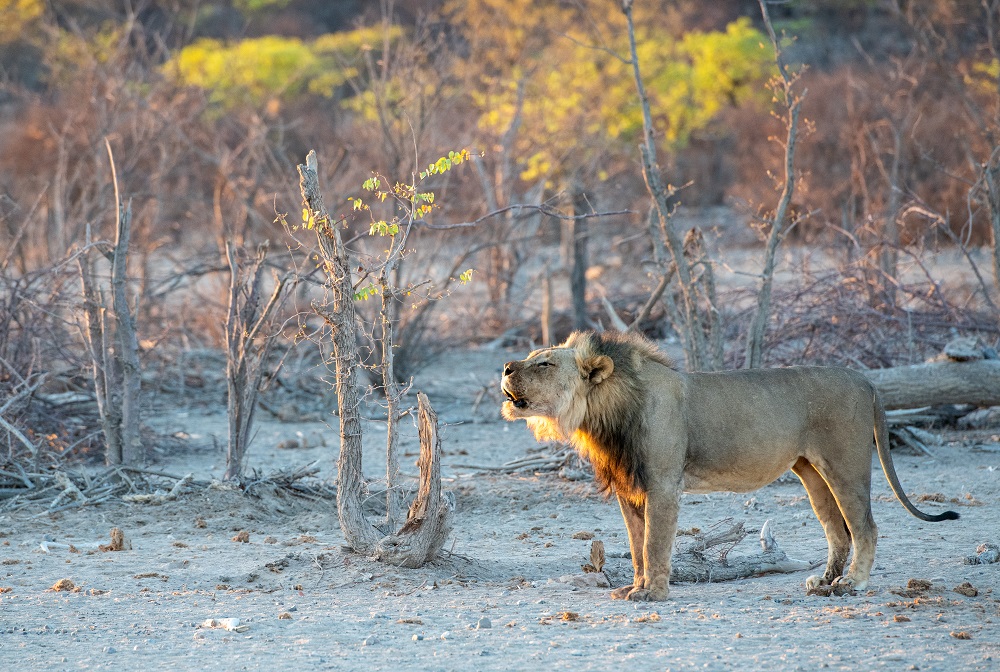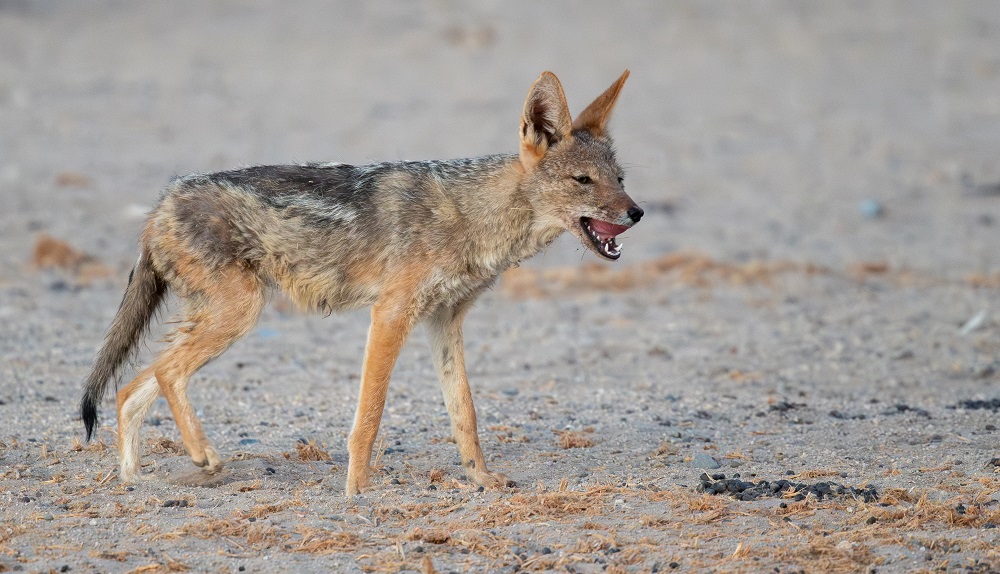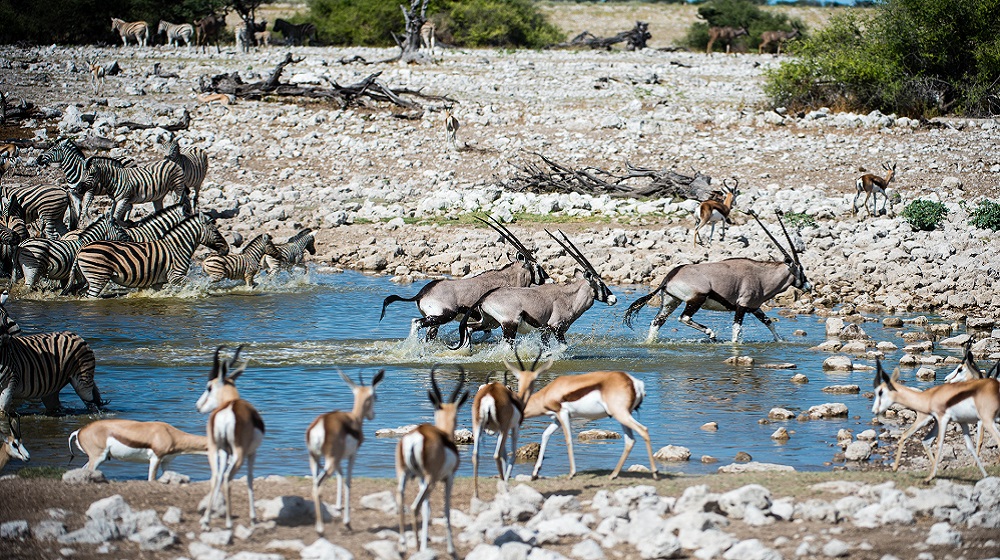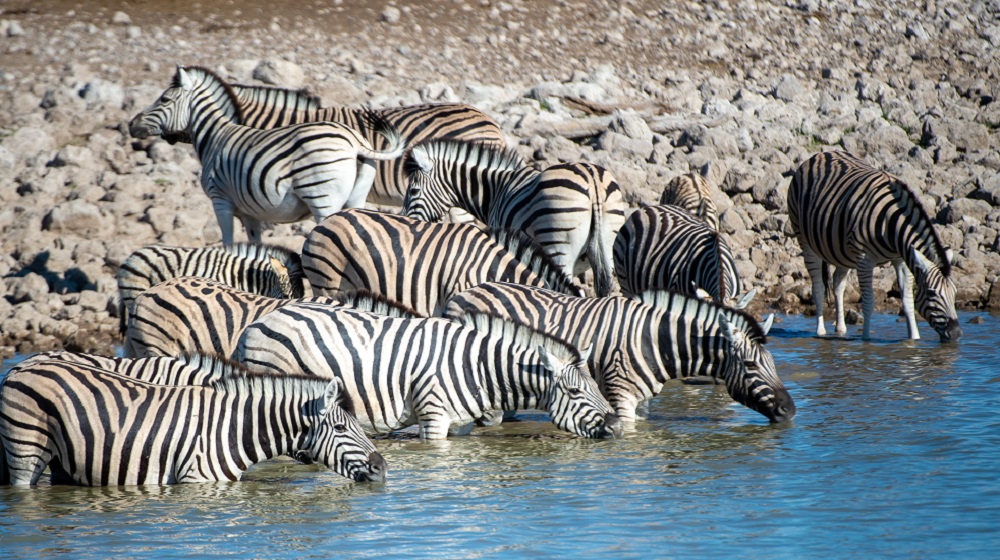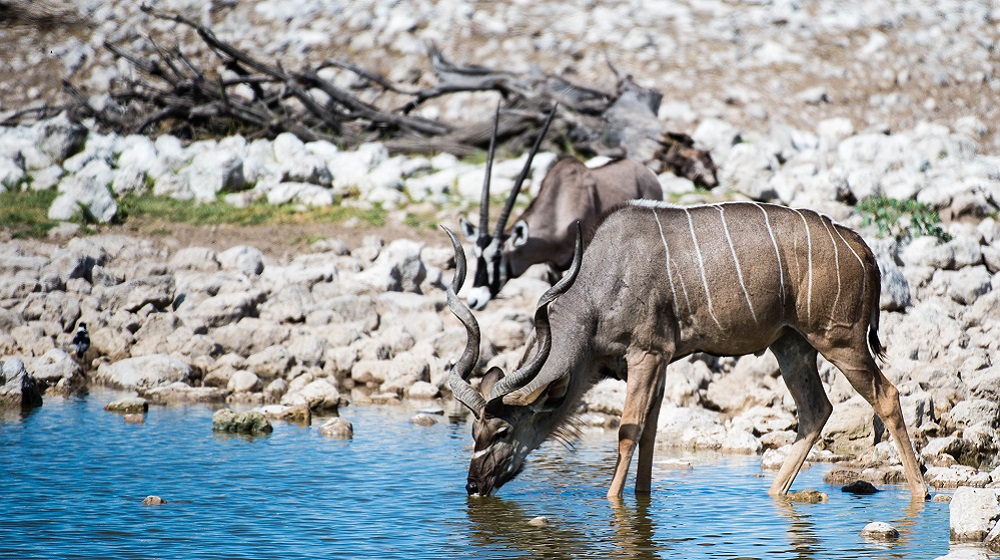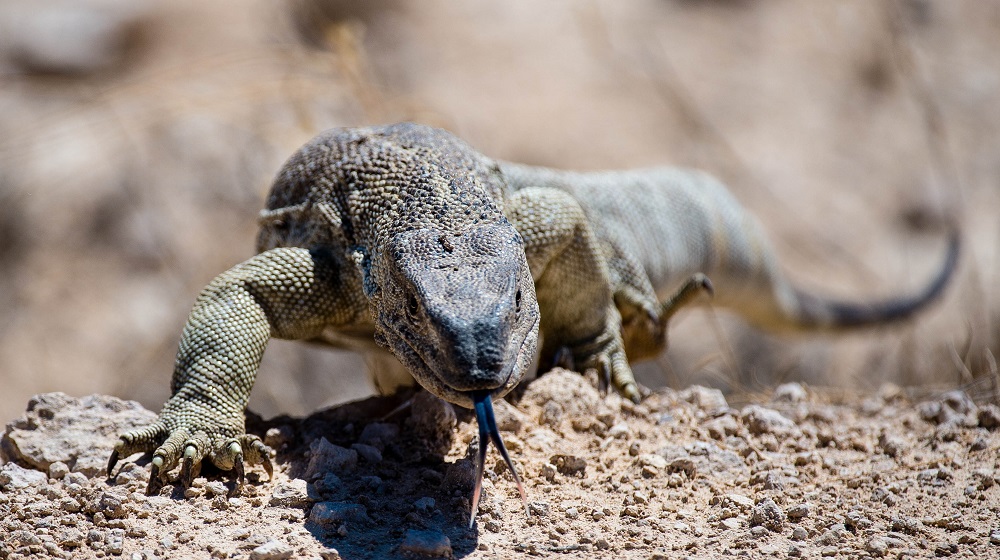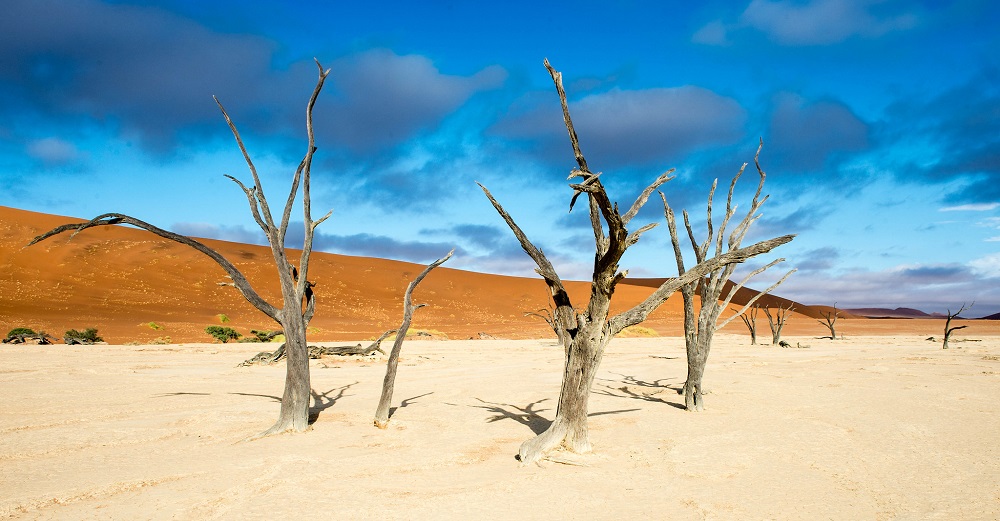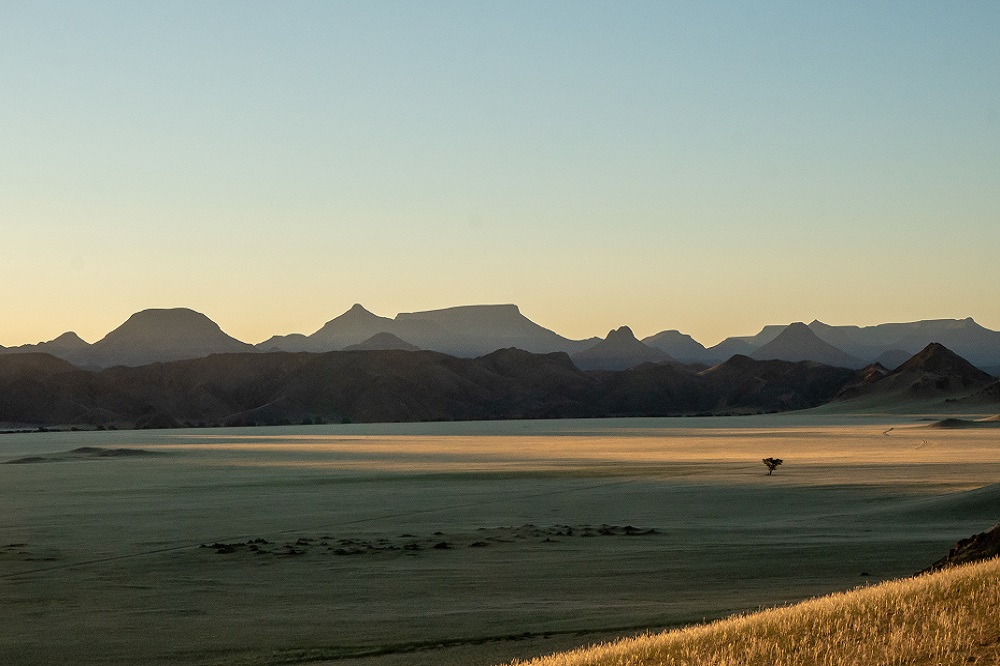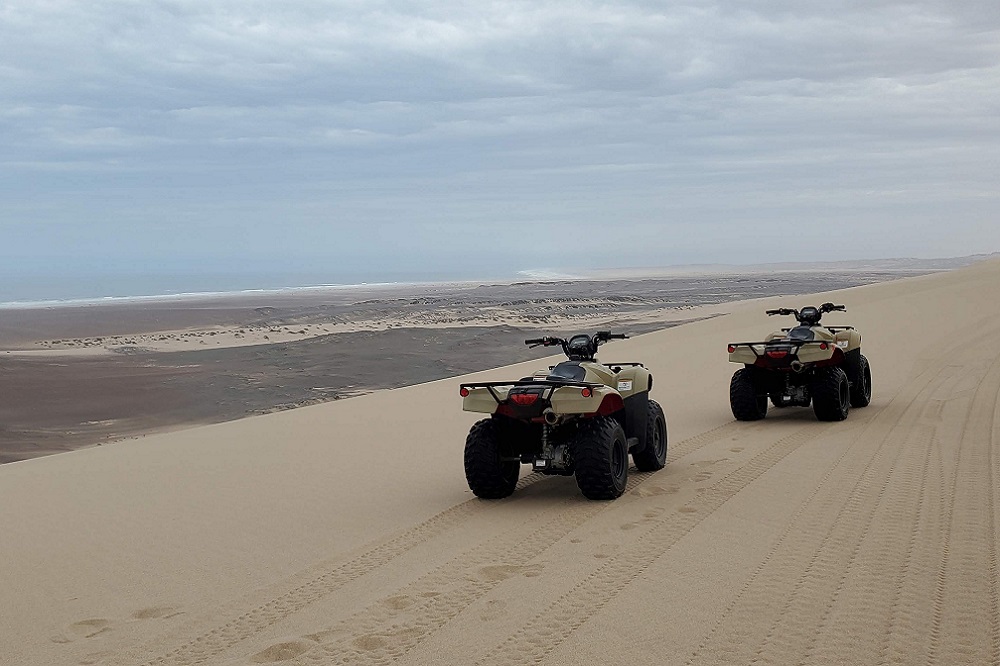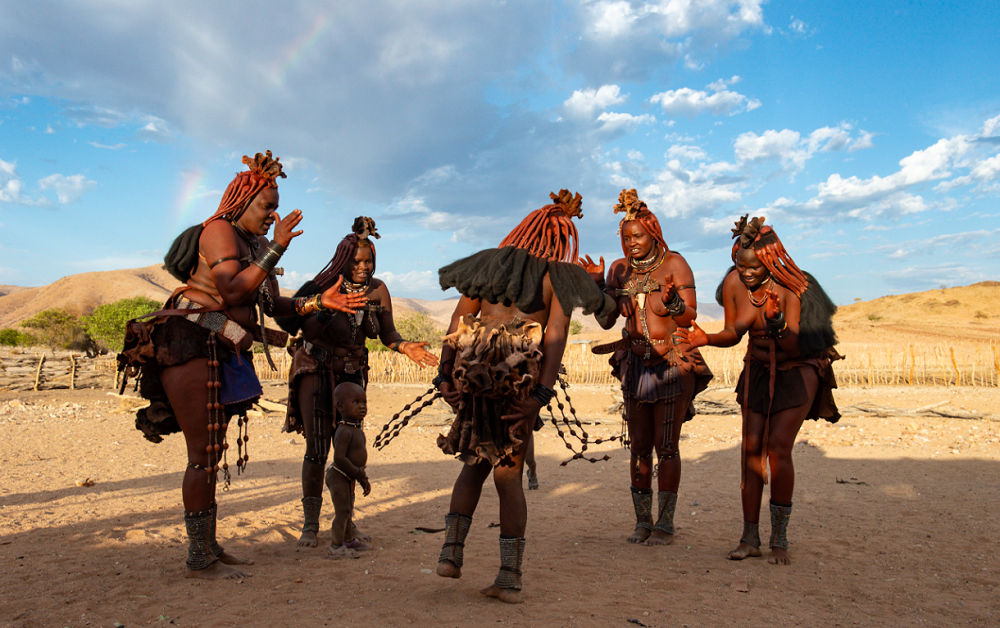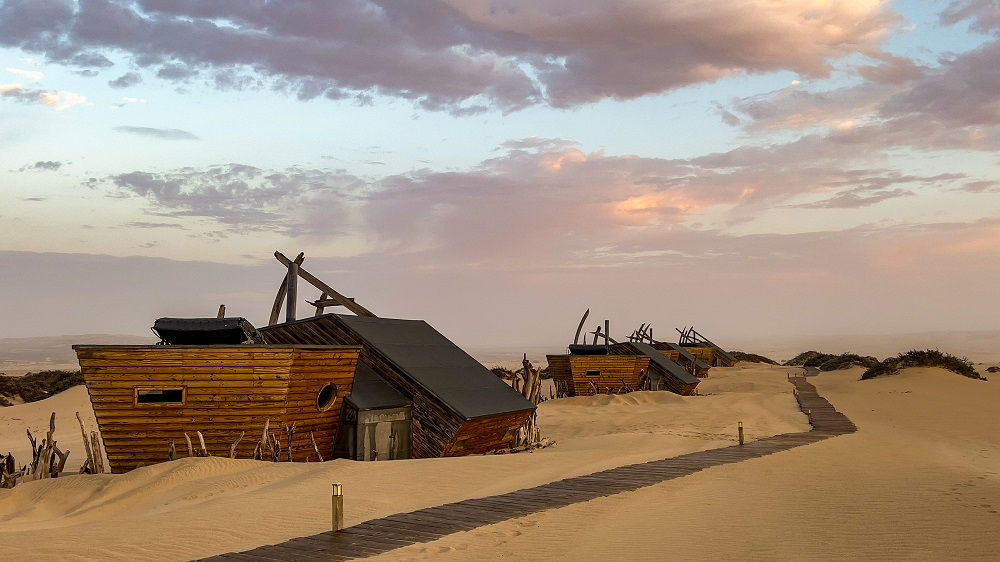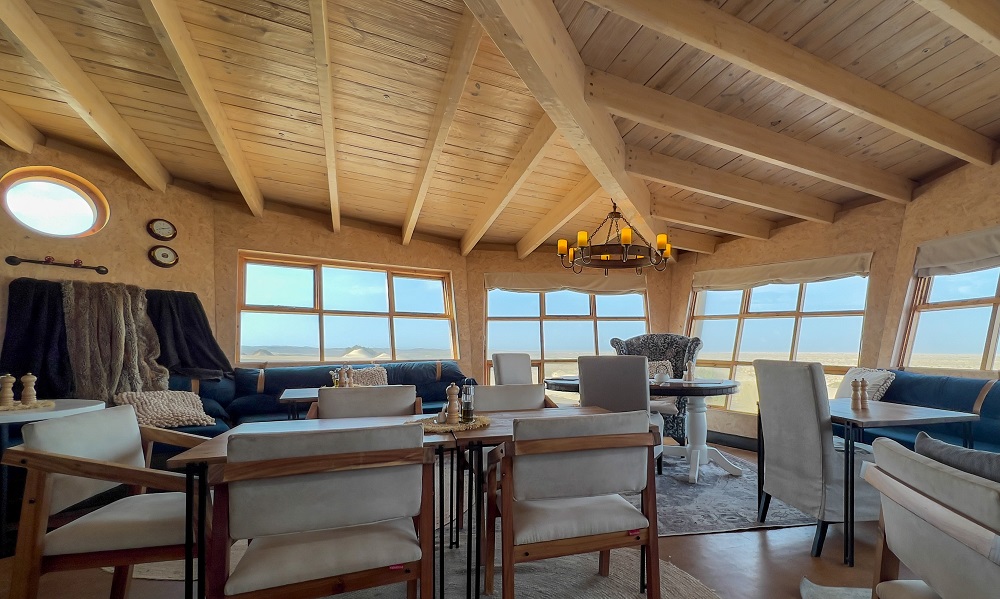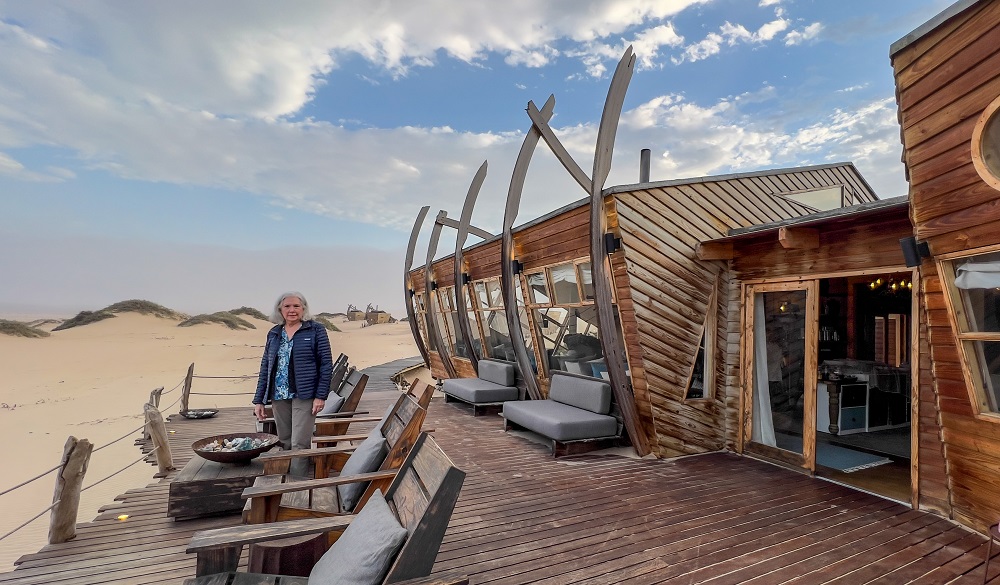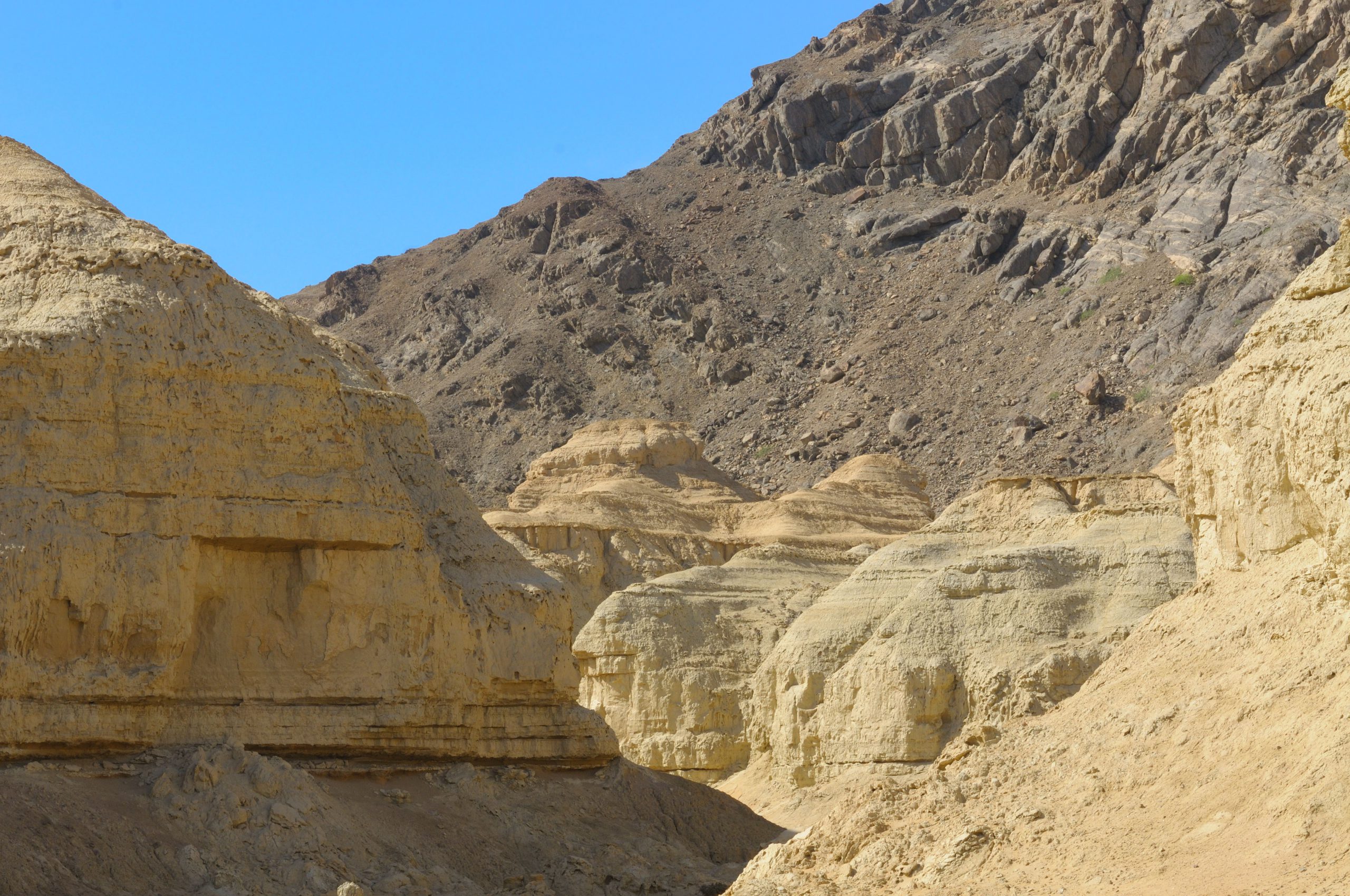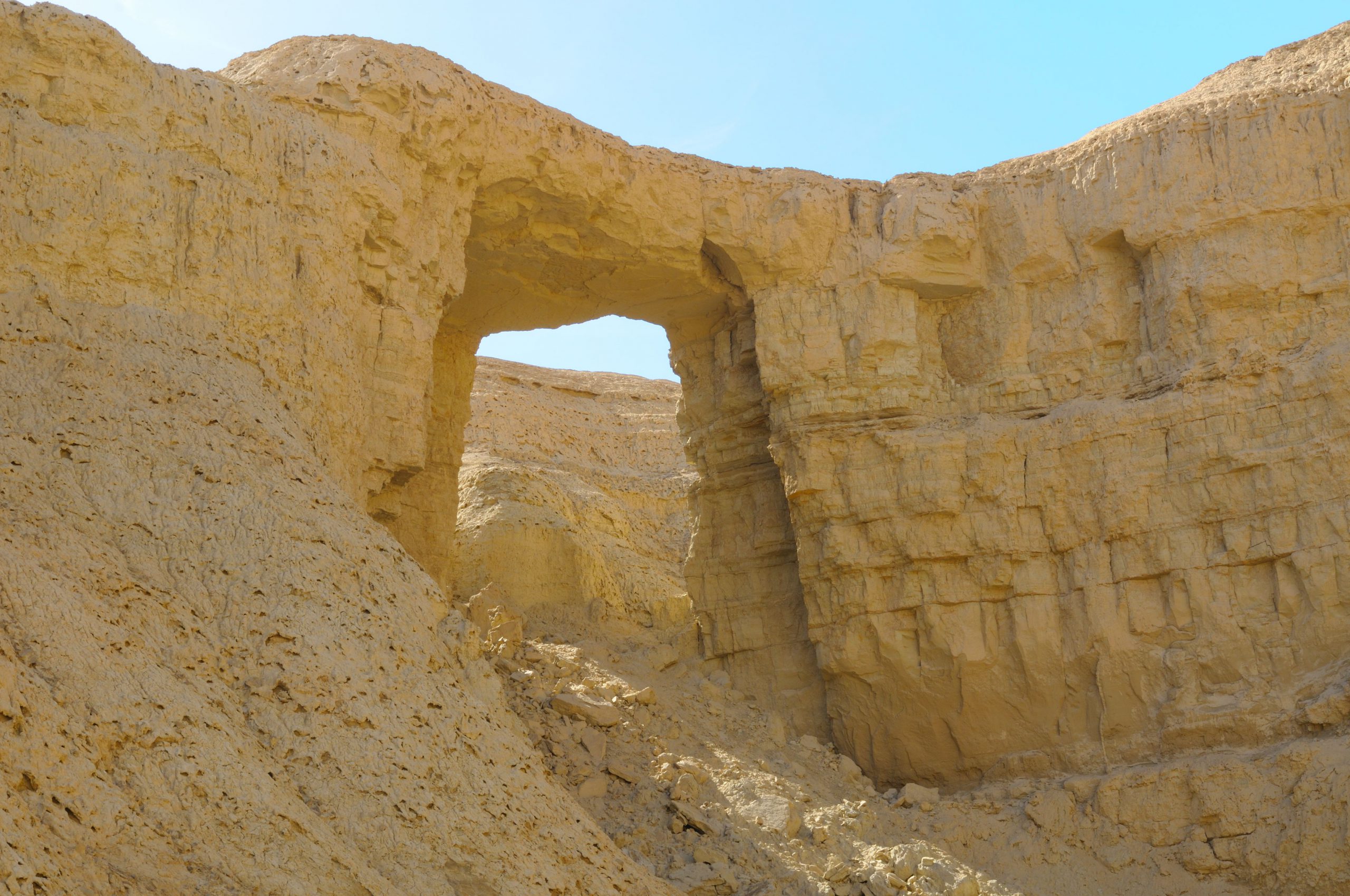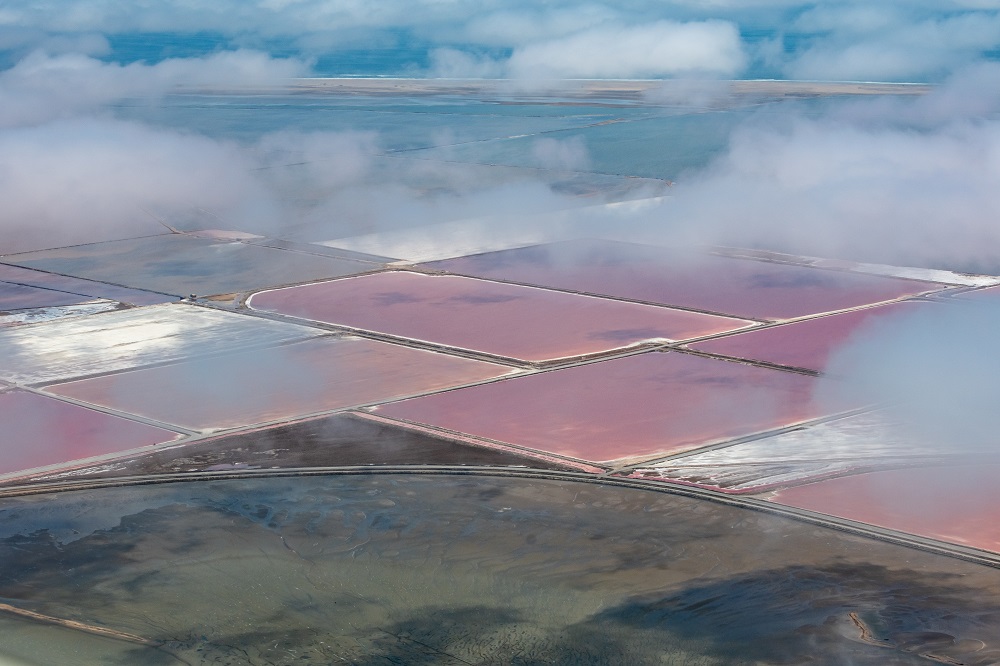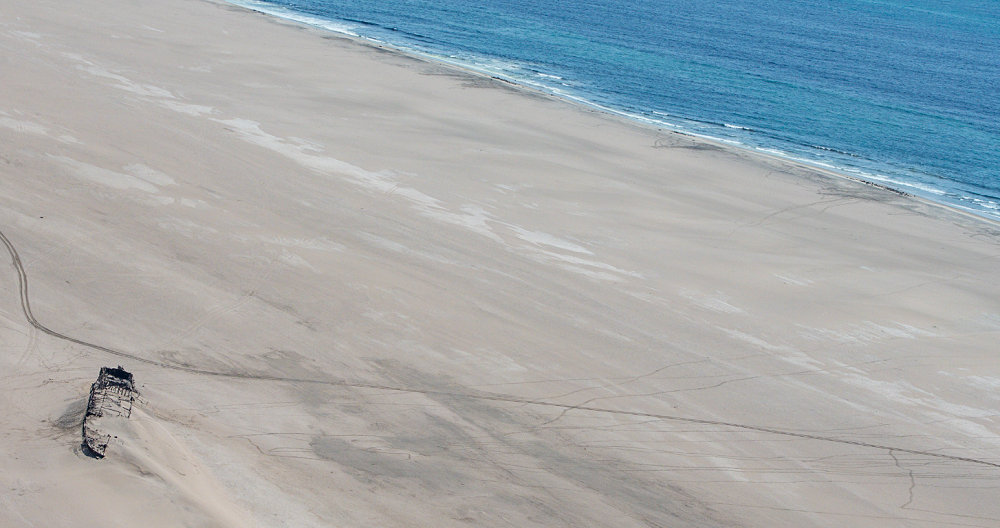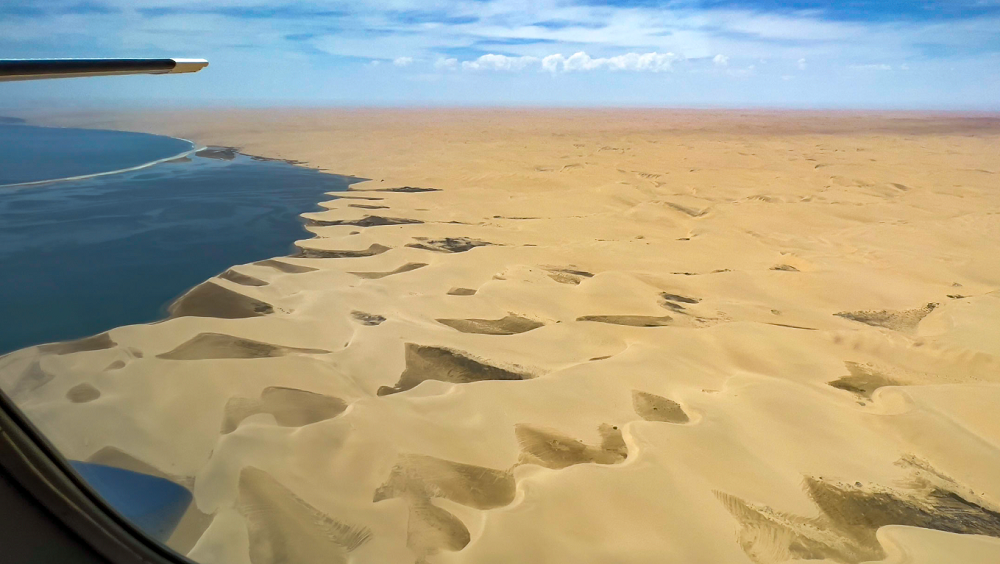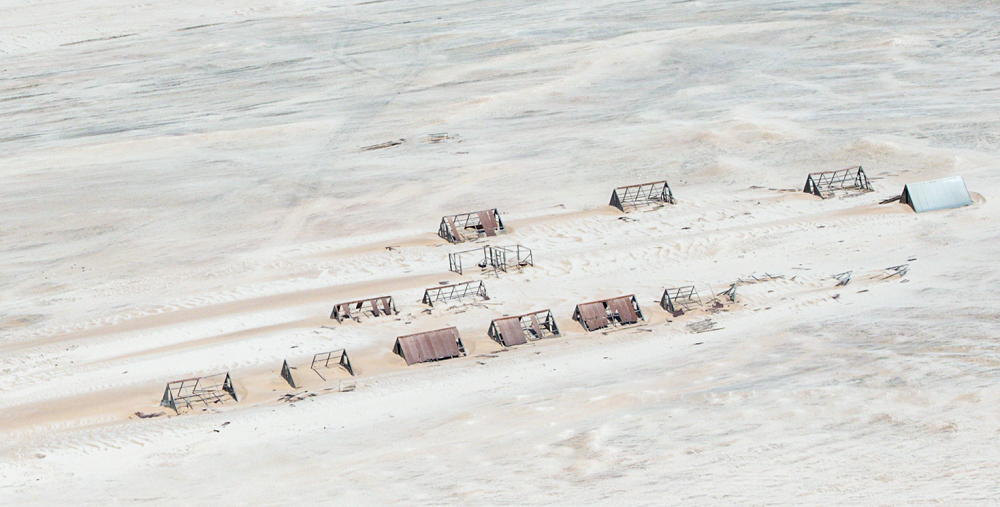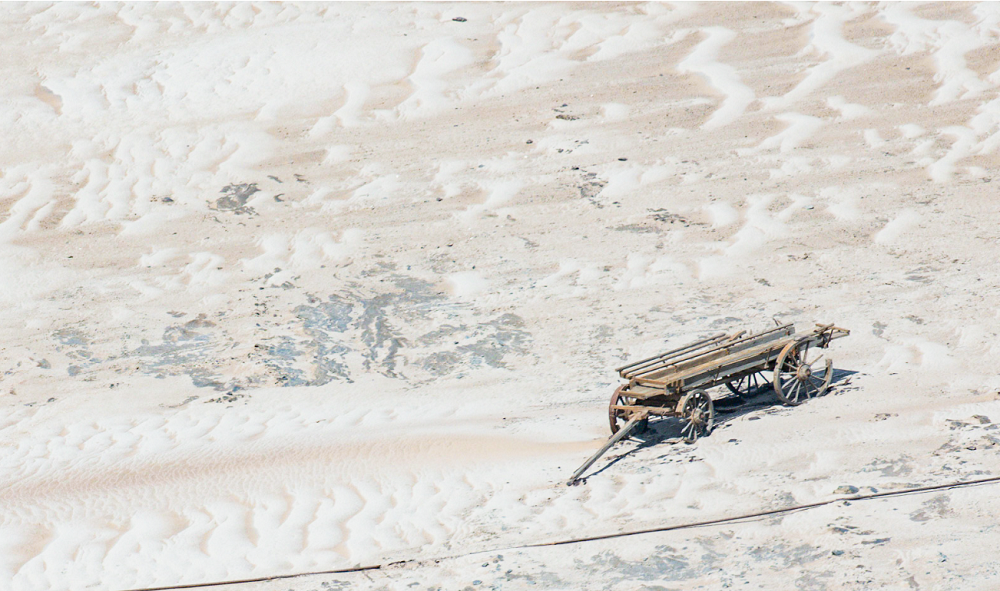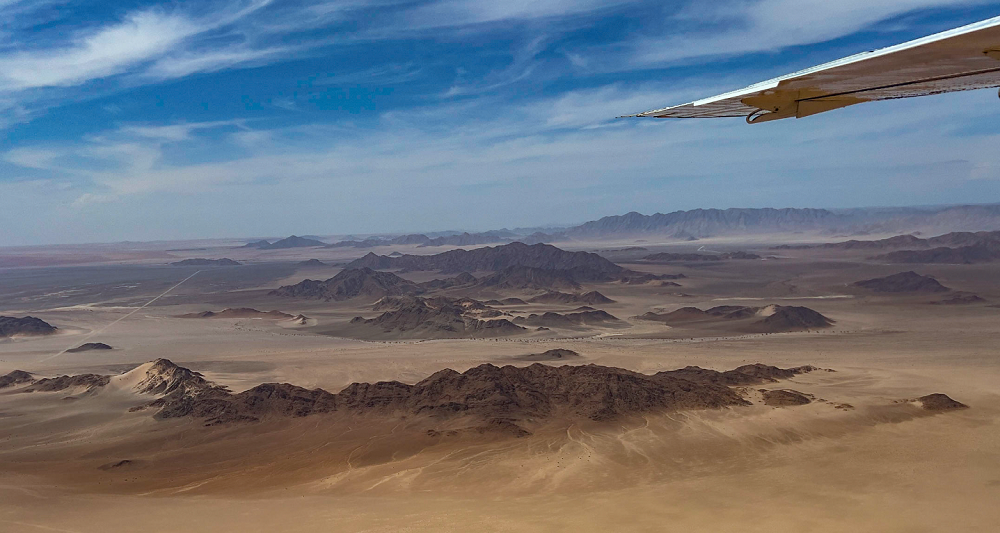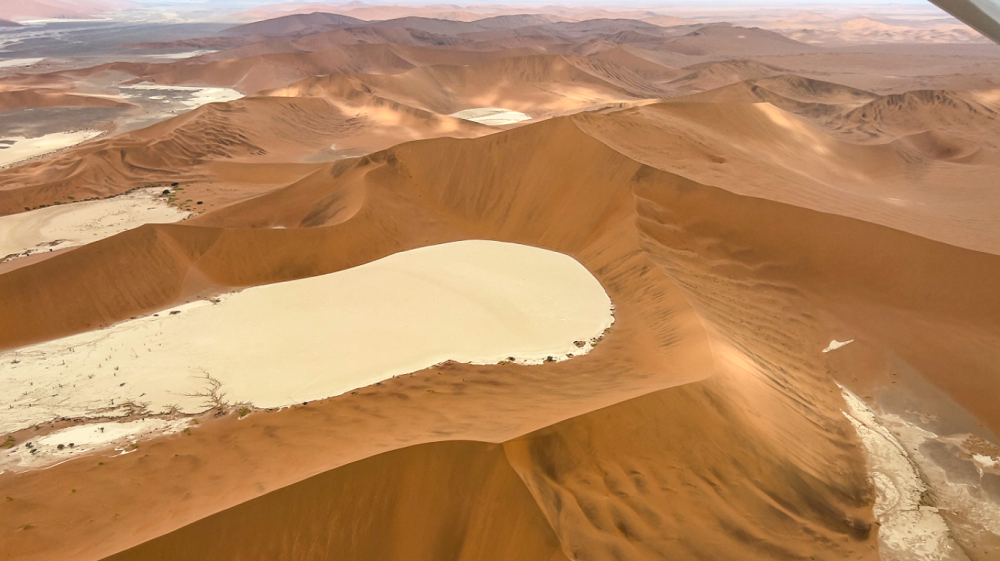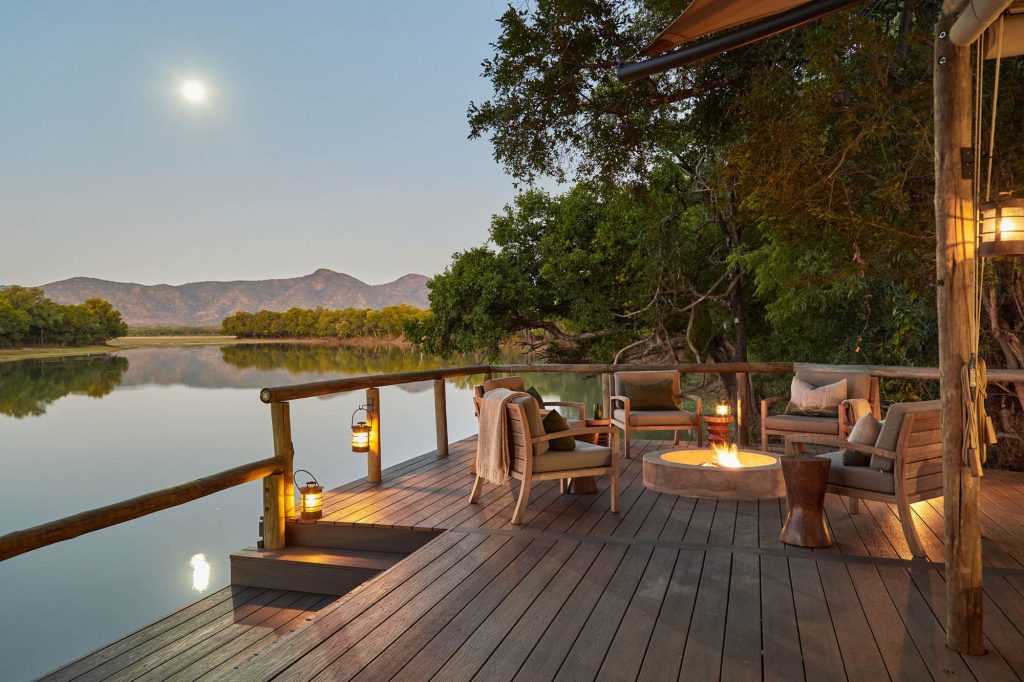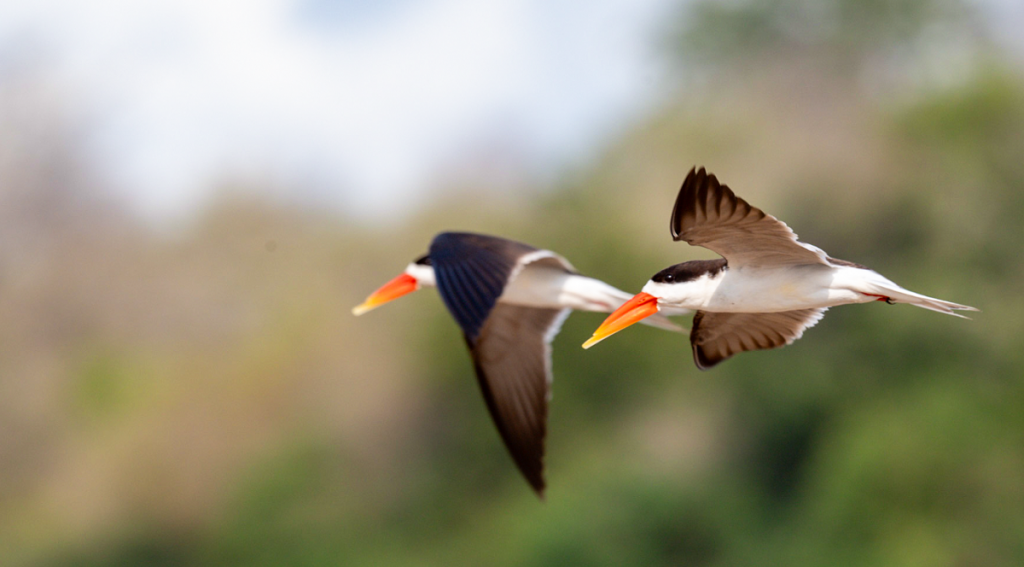Back to Namibia with Ultimate Safaris
What is it that attracts us most to Namibia in southwestern Africa? Its astonishingly beautiful desert & dune landscapes? Its fascinating people? Its diverse wildlife? On a recent 16-day guided road trip with Ultimate Safaris we experienced all of those and came away with renewed passion for this vast, sparsely populated country. One lasting impression of this journey, which included the Etosha area, Damaraland, parts of the Kaokoveld, the Hoanib River Valley, Skeleton Coast National Park, Swakopmund and Sossusvlei? That the wildlife experience is underrated. We saw lots of animals, often in arid areas where you’d least expect them.
On our very first afternoon game drive out of Natural Selection Safaris’ Safarihoek Lodge on the western edge of Etosha National Park in Namibia, we saw our first two black rhinos, a mother and a youngster. Not twenty minutes later we saw another one. And shortly after that, two gorgeous black-maned lions. Soon to be followed with good numbers of springbok and giraffes, several elephants, eland, gemsbok, zebra, kudu, steenbok and red hartebeest. The game viewing in the Etosha area – as well as in the Hoanib River Valley – was exciting and fulfilling. As was the birdwatching, with our party of six persons seeing and identifying just over 100 species in less than two weeks – without turning the trip into a hard-core birding expedition. We were ably and professionally guided by Sebastiaan Meyer, a native of Namibia.
What did we not see? Other vehicles. The private Safarihoek reserve was just that. Private. We pretty much had the place to ourselves, sharing game sightings with no more than one other vehicle at any time. The same held true for the duration of the trip. Once we entered the Kaokoveld region and beyond, all the way into the far flung Hoanib River Valley and Skeleton Coast National Park, we were essentially on our own. Often, many hours would go by without seeing another vehicle or humans, other than in the camps where we stayed. Just the way we like our Africa trips to unfold.
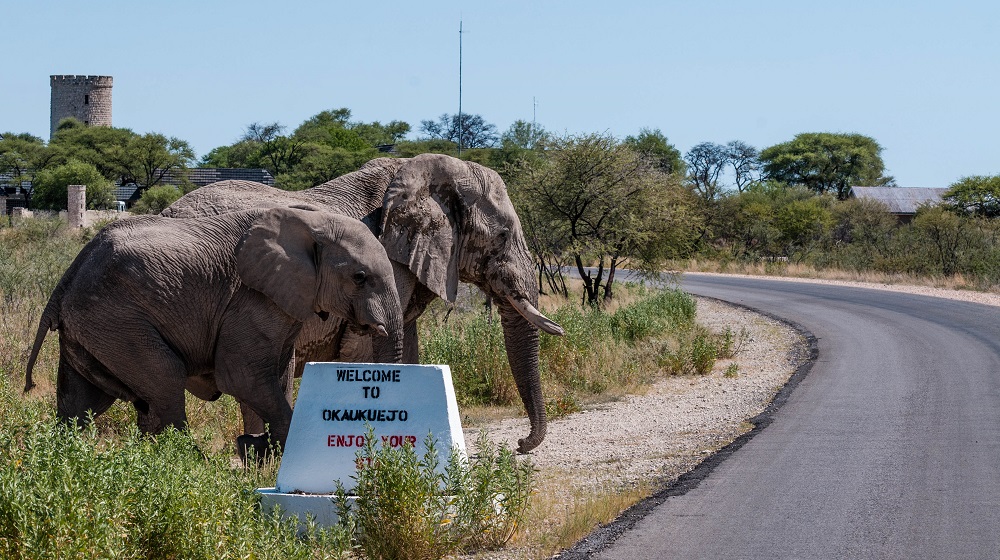
On an all-day trip into the massive Etosha National Park we observed several other mammal species – once seeing as many as eight different species at the same water hole. Inside Etosha, which is a public park, there was, predictably, more traffic. Mostly at water holes near Okaukuejo and Halali, two of the rest camps inside the park. The same was true at Sossusvlei – the setting of Namibia’s most popular concentration of gigantic red sand dunes.
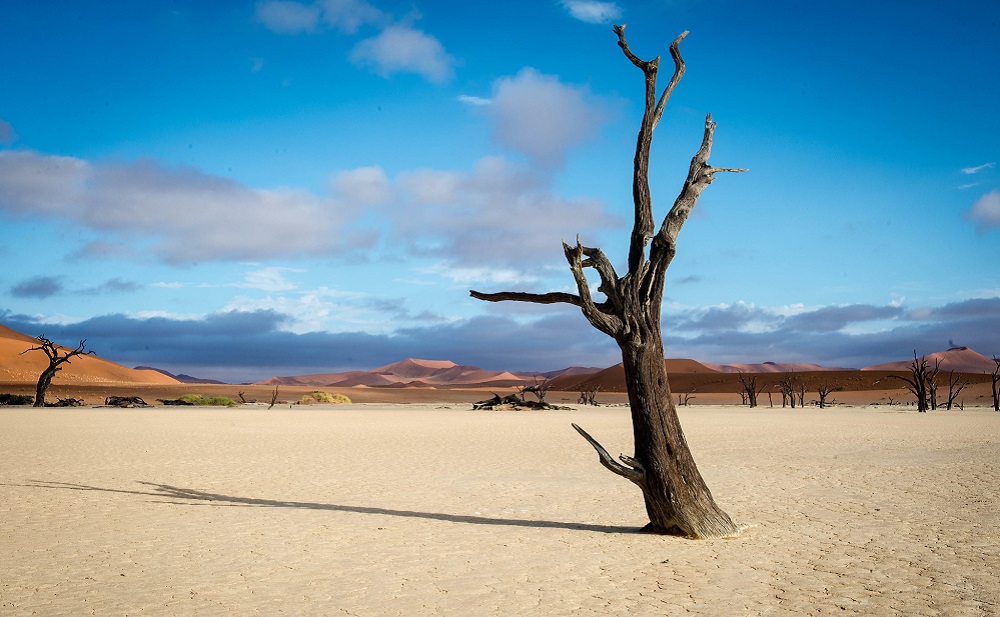
Visiting Namibia is a multifaceted experience. As we saw in the Etosha area and elsewhere, the game viewing and bird watching experience often rivaled better known safari destinations such as Namibia’s southern and eastern neighbors South Africa and Botswana.
Namibia is so much more than a traditional safari location though. Its extraordinary desert and dune experience, its cultural and scenic diversity and seemingly inexhaustible range of unique activities put it firmly into the ‘one of a kind’ category. If Namibia were a living organism, it would be like the secretary bird – the only species in its own family. There’s simply nothing else like it.
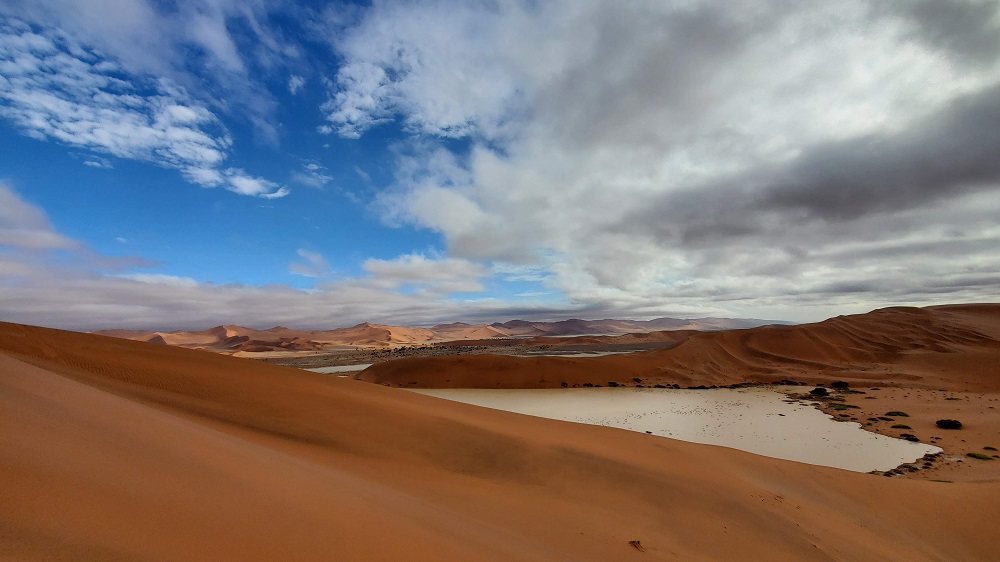
What makes Namibia, Namibia?
A prospective visitor to Namibia would do well to contemplate Namibia’s size before anything else. It is vast. About two and a half times the size of Germany, and bigger than twice the size of Texas, Namibia is huge. A roughly rectangular country, Namibia is about 600 miles deep, and between 300 to 450 miles wide. It has a long, narrow eastern extension in the north, the Zambezi Region, formerly called the Caprivi Strip. While it is possible to spend just a few days in the country – by visiting just Sossusvlei and the Skeleton Coast for example – it is far from ideal. It really takes a full two weeks to get beyond just scratching the surface of this behemoth of a country .
There are simply too many places to visit and things to see and do. Here are the top of the pops:
- The Sossusvlei area with its magnificent red sand dunes, arguably Namibia’s signature sight.
- The vast Etosha National Park and surrounding private wildlife sanctuaries for their array of wildlife with elephants, rhinoceros, oryx, zebras, kudus and giraffes being some of the more prominent sightings.
- Damaraland with its stark, rockstrewn landscapes and seemingly inhospitable surroundings, home to several desert-adapted animals including elephants and black rhinos.
- The quaint, laid back seaside town of Swakopmund with its many attractions ranging from its beach to restaurants to museums, desert excursions and adrenaline adventures including quad biking, sand boarding and skydiving.
- The remote and utterly fascinating Skeleton Coast National Park with its otherworldly scenic beauty, its incredible variety of dunes and other geological formations and a colorful history replete with tales of survival and disaster, of shipwrecks and rescue sagas.
- Beyond these, there are many other areas which may profitably be included on a Namibia itinerary. The intriguing Fish River Canyon in the south, the old coastal diamond town of Luderitz, the game-rich Waterberg area and various spots in the Zambezi region which is similar to northern Botswana in many respects.
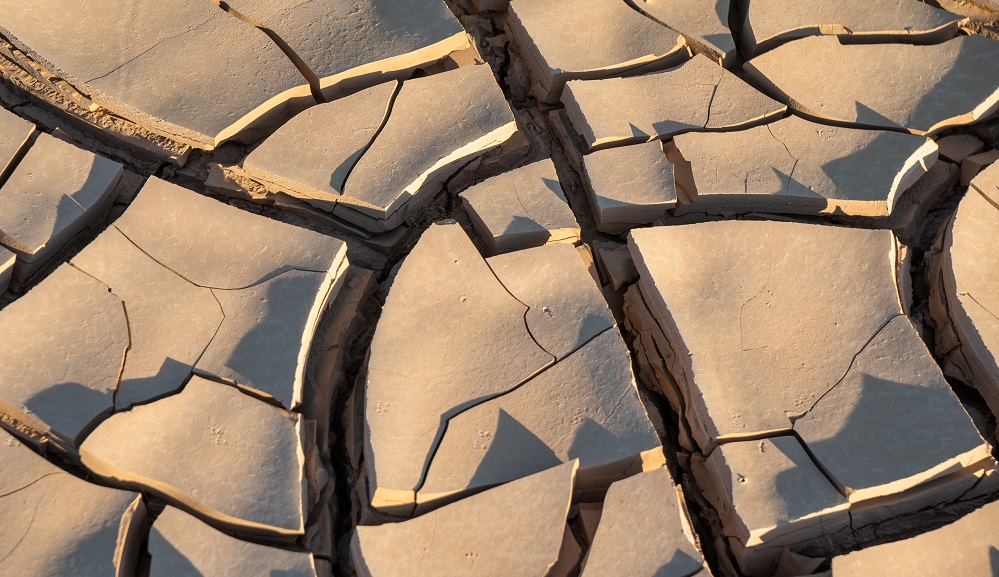
A road trip
With its size and geological as well as habitat diversity and scenic wonders, much of Namibia lends itself to a road trip exploration. Around almost every corner, there’s something to see. A notable exception? The mostly flat, featureless and sparsely vegetated landscape along the main road leading north out of Windhoek. The road to Etosha. Many first time visitors to Namibia probably start second guessing their choice of destination after three uneventful hours of traversing this scrubby vastness.
With just three nondescript towns punctuating the journey to the north – Okahandja, Otjiwaringo and Outjo – it is a relief to start seeing some wildlife as we did upon reaching the Etosha Heights private reserve.

Safarihoek Lodge, Etosha
Located on a ridge with an exceptionally good view over the wide open plains of far western Etosha National Park, Safarihoek and its sister property Mountain Lodge form a comfortable and well situated base for an exclusive wildlife experience, away from the hustle and bustle of Etosha National Park but with most of the same animals being present.
There are 9 large accommodation units at Safarihoek along a sturdy concrete walkway leading out from an attractive main lodge. They feature air-conditioned bedrooms, showers and baths (hot water available 24/7), ample storage space, good lighting, a fridge stocked with drinks and a tea and coffee making station.
We enjoyed most of our meals al fresco, poolside. The food received mostly good but mixed reviews from the members of our party. The spacious and inviting lounge had several smaller seating areas with comfortable chairs and couches, a central bar area, and a counter where tea, coffee and other beverages as well as cookies and snacks were available at any time.
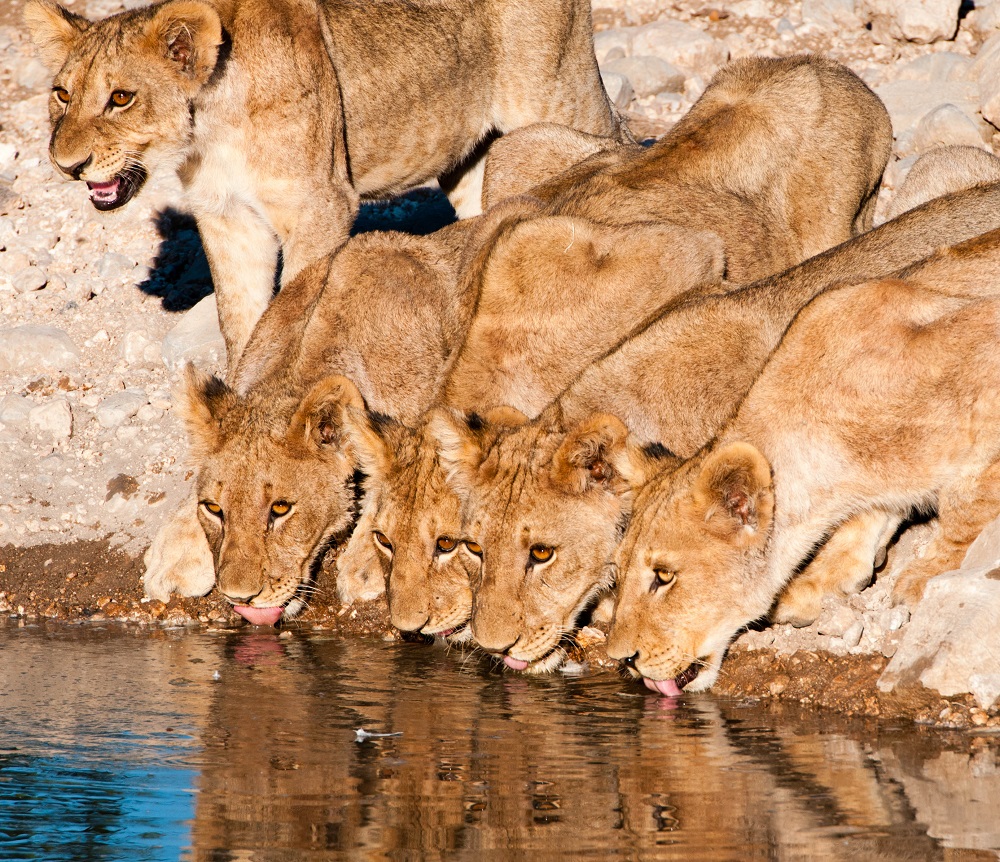
Our game drives – in an open 4 wheel drive vehicle – essentially took us from one waterhole to the next. The entire concession was bone dry with hardly any vegetation to be seen, with the exception of the mopane trees which come into full leaf in October, rain or no rain. Occasionally dodging clouds of dust kicked up by our own vehicle – and just as often being engulfed by them – we were surprised by just how many mammals could survive in this inhospitable environment. Gemsbok, steenbok, impala, giraffe, kudu – the plains game species were certainly not uncommon. Of course we were thrilled to spot some black rhinos at the base of the dolomite hills, there were lions at the waterhole in front of camp, and we came upon a nice breeding herd of elephants, moving through the mopane like so many white ghosts, covered in dust.
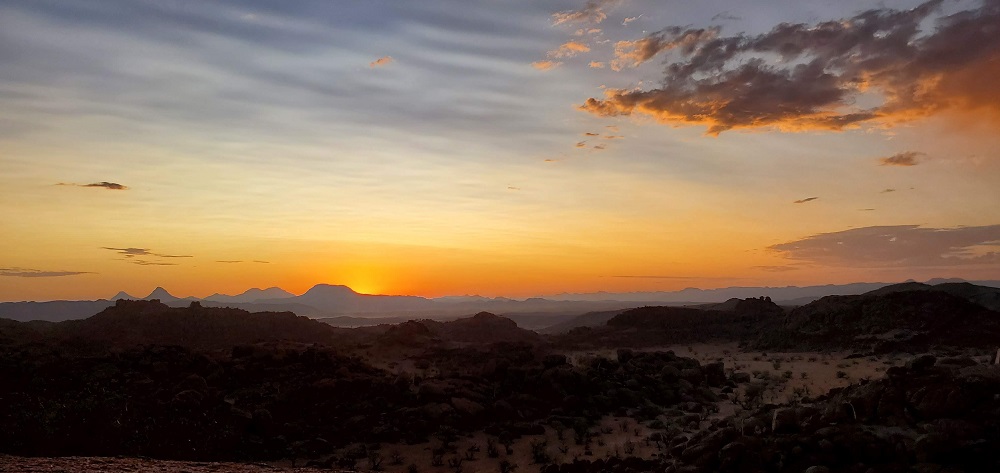
Mowani Camp
Right among a cluster of gigantic boulders in a setting which would have done the Flintstones proud, we sat down for a delicious lunch at the imposing camp Mowani. Literally built into a gigantic boulder field at the summit of a hill, most of the well appointed thatched rooms in this compact property have excellent views over distant hills and rocky outcrops, all eventually merging into the dusty distance.
It had been a long yet not uninteresting journey from Etosha, observing the landscape around us slowly transform from well-vegetated savanna to the stark, rock-strewn hills and valleys of Damaraland. The drive ended just in time. Having driven up a hill through a series of bigger and bigger rocks, eventually squeezing between two tank-sized boulders, we realized that our new home for the day might be something special. From the welcoming chat to the selection of lunch items, Mowani Lodge made a good first impression. There was no subsequent letdown. Sundowners from an elevated lookout point, a dip in the pool and a tasty private dinner alongside a fire pit. What’s not to like! Everything was done nicely and tastefully and the staff were friendly to a fault.
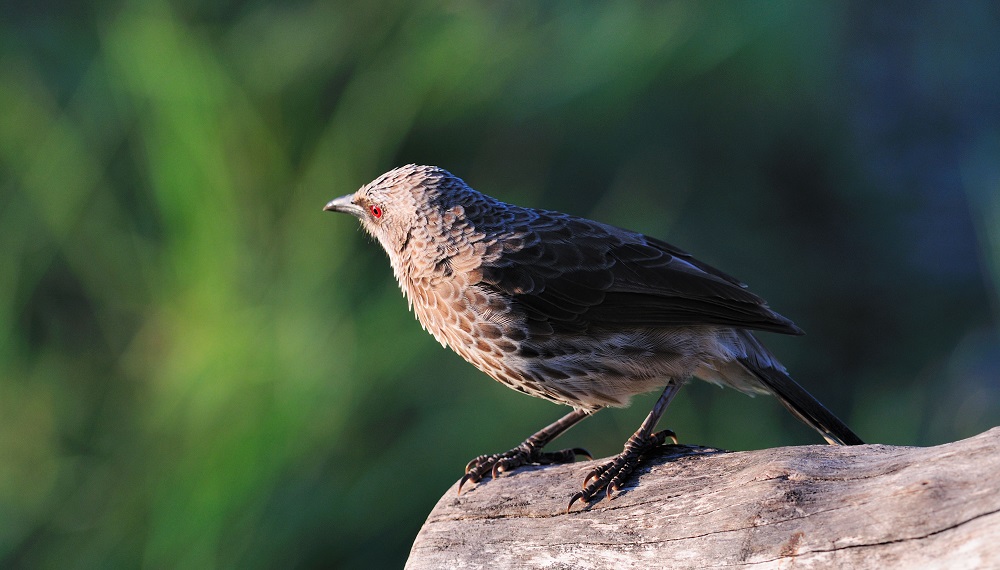
With a water feature attracting a variety of birds, a small waterhole a distance away from camp (where we noticed some Damara dik dik) and a small rock-enclosed pool, Mowani always has something to see or do. On the morning we left, we observed a bunch of rock dassies (also known as hyraxes) emerge from their sleeping area and clamber high up into a nearby tree like so many holiday ornaments, feeding from the leaves.
The thatched rooms at Mowani had very comfortable beds with soft pillows, a separate shower and toilet, adequate lighting and enough space for storage. They were private and most had an elevated lookout point over the spectacular landscape. Perfect? Not quite. For some reason there was a sizable step up from the bed level to the center of the room, resulting in several expletives being aired there as we – predictably – stubbed our toes on it more than just once.
From Mowani we made two excursions:
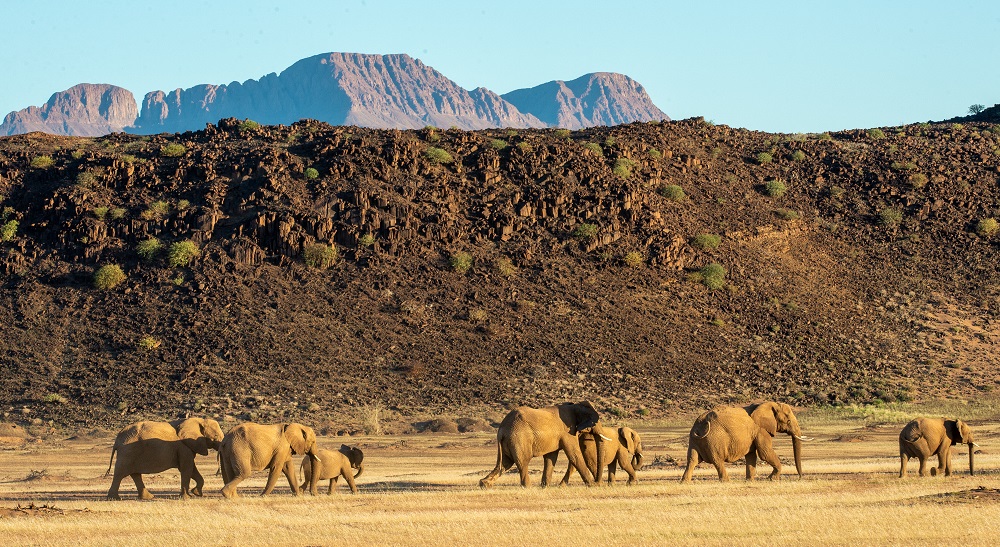
Desert-adapted elephants
Several small herds of desert-adapted elephants are to be found along the watercourse of the mostly dry Aba Huab and Huab rivers. The elephants concentrate along these so-called linear oases where there is plenty for them to eat in the way of mopane trees, other shrubs and their foliage and particularly the seed pods of the Camelthorn trees. We tracked and subsequently found a small herd of about seven elephants. They were working their way from one source of food to the next, clearly quite comfortable with the presence of vehicles. Every now and then one would walk in front of a line of dunes as if to visually prove its status as a desert-adapted pachyderm. Photographs were duly taken. It was a fun outing and despite the presence of many other safari camps and lodges in the area, we saw only two other vehicles who also had desert elephants on their to-do list.

Twyfelfontein rock art
Walking with an interpreter guide through the collection of petroglyphs at Twyfelfontein – a World Heritage Site – invariably makes one think about the artistry and creativity of these long gone San hunter-gatherer people, as well as about their need to communicate beyond their own circle. It soon becomes evident that they wanted others to know about water holes and not just the location. Some were clearly designated (with a dot in the middle of a circle) as perennial and others as seasonal. The ancient rock scribes also wanted to spread the word about the wildlife to be found in the area. Right down to which ones potentially posed a threat to humans. Little did they know that their rock telegrams would reverberate through the ages and that some of their messaging would become truly timeless. Worth visiting? I think yes. Take some water; it’s a rather long and at times searingly hot and dusty walk to make it to the start of the trail. And wear sturdy shoes – there’s plenty in the way of uneven terrain and some light clambering involved. One thing that can and should be done? The truly abominable reception building should be razed to the ground and rebuilt. It is really a dump.

Hoanib Valley Camp
Our Namibia road trip took an adventurous turn the moment we took a left turn off the gravel road a few kilometers out of Sesfontein, a desert settlement in the Kaokoveld. Suddenly we found ourselves in what might have been a movie set for Indiana Jones or Mad Max (Mad Max – the Tom Hardy one – was filmed in Namibia). Driving helter-skelter through the desert, dodging patches of ominously thick sand, we were glad to have an experienced guide – Sebastiaan – behind the wheel. Someone who knew where he was going and who had the 4-wheel driving skills and experience to get us there. Not one of the rest of us could check any of those boxes.
The sense of being in a remote special place became even more palpable as we dipped down into the dry riverbed of the Hoanib River. It was oppressively hot but our anticipation of what lay ahead trumped any discomfort we may have been experiencing. The sandy track wound its way ever further into what was as far away from a populated center as some of us may ever have been.
An hour or so after entering the Hoanib valley we turned right on a narrow track, followed a stone lined driveway for a bit before entering into a sheltered canyon through a narrow rocky gap. We were all mightily relieved to see structures – a semi-circle of tents facing down in the direction of the riverbed. Our base for the next three nights.
Minutes later we were being introduced to the vivacious manager of Natural Selection’s Hoanib Valley Camp – Petronella Daniels – and her team. Welcoming soft drink in hand, we marveled at the view over the valley sloping down gently to the Hoanib River.
The six tented rooms at Hoanib River Valley camp are located to the left and right of a good sized lounge and dining room. The rooms are reachable along a paved, yet somewhat sand strewn walkway. I thought the rooms were rather too close to each other but it is a minor criticism as they are otherwise exceptionally comfortable and well designed.
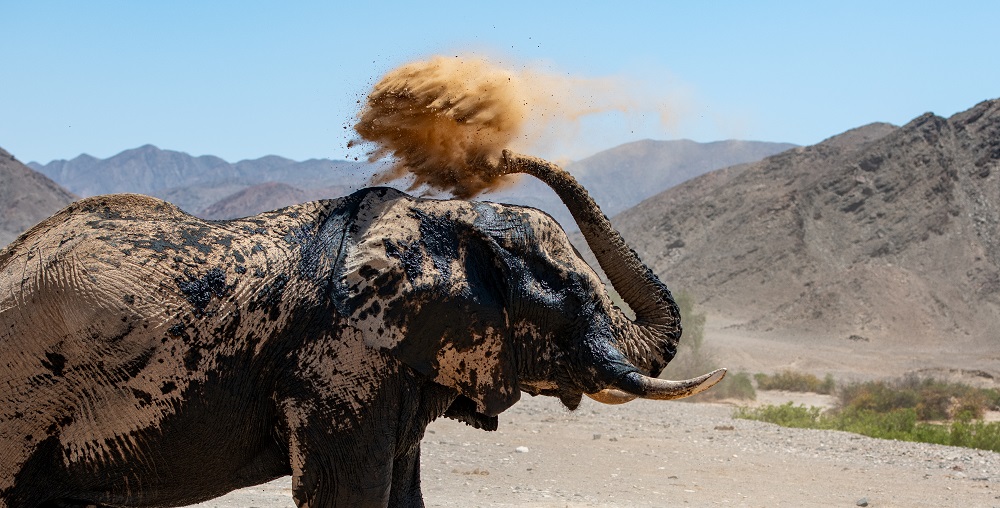
Our activities at Hoanib Valley Camp consisted of morning game drives traveling further west downstream along and in the Hoanib riverbed, afternoon sundowner drives, and a Himba village visit. With local guide Ramon Coetzee behind the wheel, we enjoyed the tandem services of two professional guides and it was fascinating to see him and Sebastiaan pool their knowledge and experience in search of the big cats.
As was the case during our first visit to the Hoanib river valley some years ago, we were pleasantly surprised by the variety of wildlife. We encountered two different small herds of elephants – one of five and another one of nine – with three young babies between them. As well as lots of springbok, several giraffes, some gemsbok and steenbok. We also added a handful of new birds to our trip list.
On separate occasions we encountered the two large bull elephants present in the area; 22-year-old Oliver and the undisputed big daddy of the Hoanib valley, Arnold, who has spent all of his 38 years under the hot Namibian sun. They were clearly masters of their domain, all but ignoring us and going about their daily routine which included voraciously feeding, drinking water, spraying themselves with water, then mud and finally dust. Incidentally, Arnold desperately needs a pedicure – his massive elephant feet and particularly his gigantic toenails are in pitiful condition.
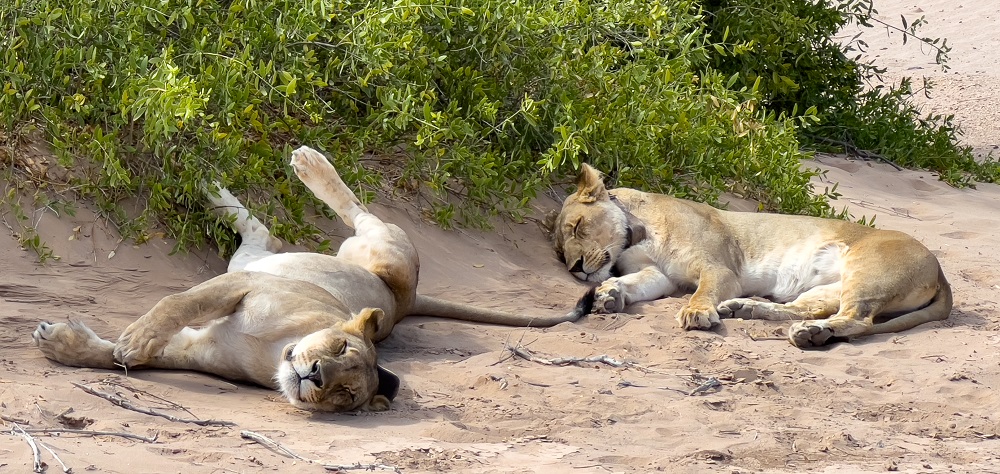
The most fascinating aspect of our two game drives was tracking two female desert lions. Ramon and Sebastiaan displayed their considerable skills as they tracked the lions from a waterhole along some small dunes and into an area well off the road where the two lions were getting ready to spend the day.
The following day was essentially a repeat performance, this time tracking the two females from where we had seen them the previous day. By then, we knew that they were known as Alpha and Bravo. The two big cats had gone on a major walkabout since we had seen them last so Ramon and Sebastiaan had to bring their A game to find the ladies again. Which they did, but after a Herculean effort of driving in what felt like circles, doubling back a couple of times, tracing and retracing the lion paw-prints in the sand. All accompanied by lots of earnest conversation between the two guides, some head-shaking and the occasional raised eyebrows. And likely a few salty adjectives associated with the lions, discreetly uttered in the local Nama language.
There are about 70 or so desert lions present in the greater Skeleton Coast and Damaraland/Kaokoveld area. Due to human/animal conflict their continued presence is under severe threat. Skeleton Coast local Dr. Philip Stander, who resides in the coastal town of Mowe Bay when he is not in the field tracking the lions, is the world’s foremost authority on desert lions. Read more about his work on the Desert Lion Conservation website.
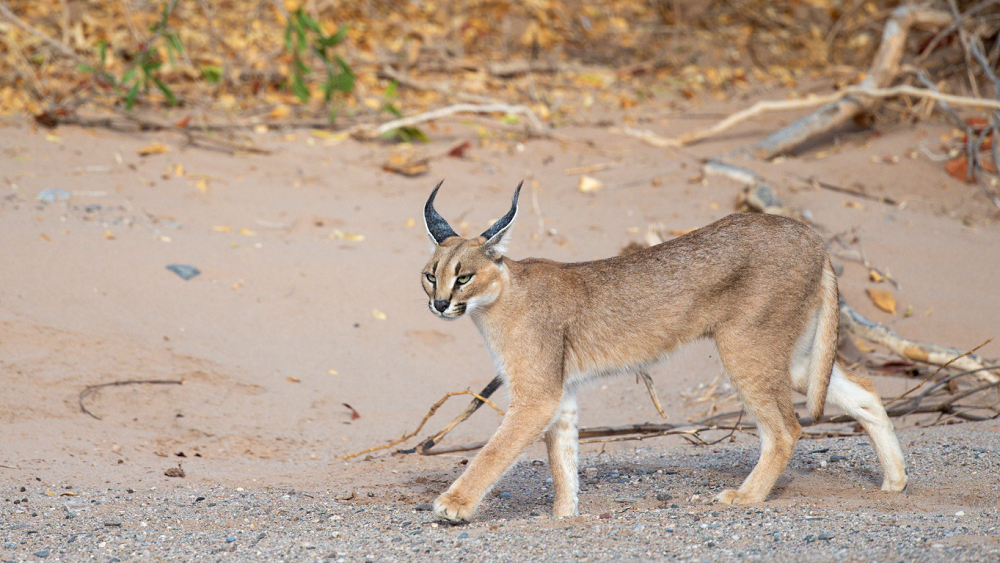
An unexpected mega sighting? A caracal crossed behind our vehicle at around 8 am one cool morning after an overnight shower had refreshed the area. It was clearly hunting, noticeably swiveling its prominent pointy ears as it stood dead still for a few seconds while surveying the area. Just once it turned its head to give us a cursory look. Even for our guides, who had spent decades in the area, it was a special sighting.
Himba village visit
Our afternoon visit to a small Himba village was fun in the old-fashioned sense of the word. I’m always a little bit apprehensive about ‘village visits’ of any kind. It can be awkward to simply show up – as a bunch of complete strangers – at someone’s home and interact with them in a meaningful manner. I need not have worried.
The six Himba women, seven or so young kids and lone Himba man which we met on the day made us feel welcome right off the bat. The ladies confidently bade us welcome on arrival and the kids acted as the perfect icebreaker. Upon seeing themselves reflected in our camera playback images, their unaffected expressions of delight and surprise, their pealing laughter and silly giggles just seemed so natural it removed any feeling of self-consciousness.
Getting a glimpse into the life of a tiny Himba village, a look at the way of life of people living an existence which is diametrically different to ours, is sobering. Clearly evident? The utter lack of material things, modern conveniences, electricity and plumbing of any kind – not even running water. It is just so hard for us to fathom living like that. Yet it was not difficult to relate to our Himba guests on a purely human level. I think we all marveled at their joie de vivre, and their wholly unaffected interaction with complete strangers. A lasting memory? Their pure joy when they were performing a farewell dance. A little improvisational at times but done with almost childlike enthusiasm and verve. We could all use a little bit more of that in our lives.

Shipwreck Lodge, Skeleton Coast National Park
Roads? Where we’re going, there are no roads! A line from Back to the Future? Not quite, but certainly applicable to the remote northwestern Kaokoveld region of Namibia, where Shipwreck Lodge was built. Unfold a map of Namibia and trace the line on the map representing the road from Toscanini to Terrace Bay to Mowe Bay. It is a dotted line. From Mowe Bay further along the coast to the north, in the direction of Shipwreck Lodge? Nothing on the map. On the ground? Just a barely visible, winding sandy track, negotiable only by four wheel drive vehicles and prone to being obliterated by creeping barchan dunes.
In the relatively short time it has been open, much praise has been heaped on Natural Selection’s Shipwreck Lodge, located on an elevated cluster of hummock dunes, overlooking the breakers of the Atlantic Ocean beach about a mile or so in the distance, directly in front of the camp.
Listening to the muted roar of the waves while sitting on the front verandah at Shipwreck is time well spent. The ideal spot to enjoy the cool beach air and to reflect on the place and the environment.
Rewinding the tape back a little to the previous day, we arrived at Shipwreck in the early afternoon in time for a late lunch. Located on the edge of a series of intricately patterned longitudinal dunes, the cozy lounge/dining room is a delightful place to spend some time, safely cocooned from the hazards of the Namib desert.
A strong south wind was visibly sweeping handfuls of sand from the surrounding hummock dunes while we received our arrival briefing and room allocation. Four of the chalets – built in the style of ship’s cabins complete with portholes and sloped windows – are to the north and six to the south of the lodge. All are identical with bedrooms looking out over a desert landscape and beyond that, the edge of the Atlantic Ocean in the distance. The rooms were just the right size and shape for the desert environment, with the light nautical touches creating a fun and whimsical atmosphere. A good strong shower, plenty of hot water, pretty good lighting – it checked all the boxes.
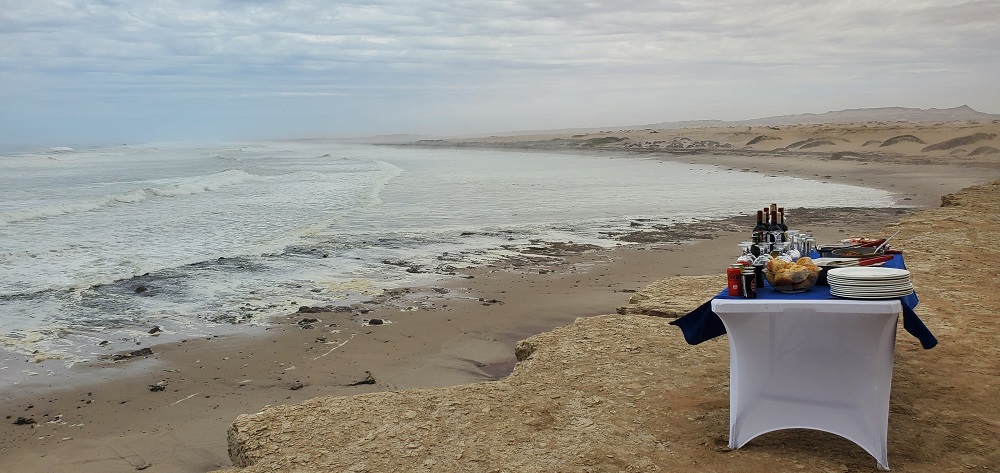
Activities include nature and dune drives, sand boarding and excursions on all terrain vehicles. We also made our way to Rocky Point on a sundowner excursion and enjoyed a lavish ‘braai’ just off the shoreline of the Atlantic Ocean, with various cuts of meat and some fish, grilled over coals. Walking from this spot just a few hundred meters in either direction imbues one with a sense of the true desolation of the area. No fresh water, no signs of habitation, essentially no vegetation. Wind, crashing waves, a Cape fur seal scampering away and a few gulls, cormorants and shorebirds flying by. It’s not difficult to put oneself in the imaginary shoes of shipwreck victims. Your prospects? Dire.
The Skeleton Coast National Park north of Mowe Bay is extremely lightly visited and as was the case pretty much throughout our Namibia visit, there was practically no one else around. The scenery around the lodge defies description. It is a mix of gigantic longitudinal and hummock dunes, an endless expanse of moving sand with the afternoon southerly winds constantly changing the look of the place. Driving a little further to the north – towards Rocky Point – we came upon a series of bizarrely symmetrical barchan dunes which are marching their way across the Namib Desert at a rate of up to 20 meters per year. Change is a constant, and today’s road is buried under tomorrow’s incipient sand dune.
We very much enjoyed the time we spent with our charming local guide Bravo Kasupi who we first met about halfway to the lodge, at a handover spot below a high bluff, at Leylandsdrift, in the Hoarusib River. After some welcome refreshments (fruit kabobs, biltong, savory snacks and soft drinks) we set off down the course of the Hoarusib, eventually checking out the impressive ‘clay castle’ formations which tower over portions of the riverbed. And then slowly, slowly making our way to the lodge, doing some birdwatching en route, and spotting several oryx along the edges of the Hoarusib.
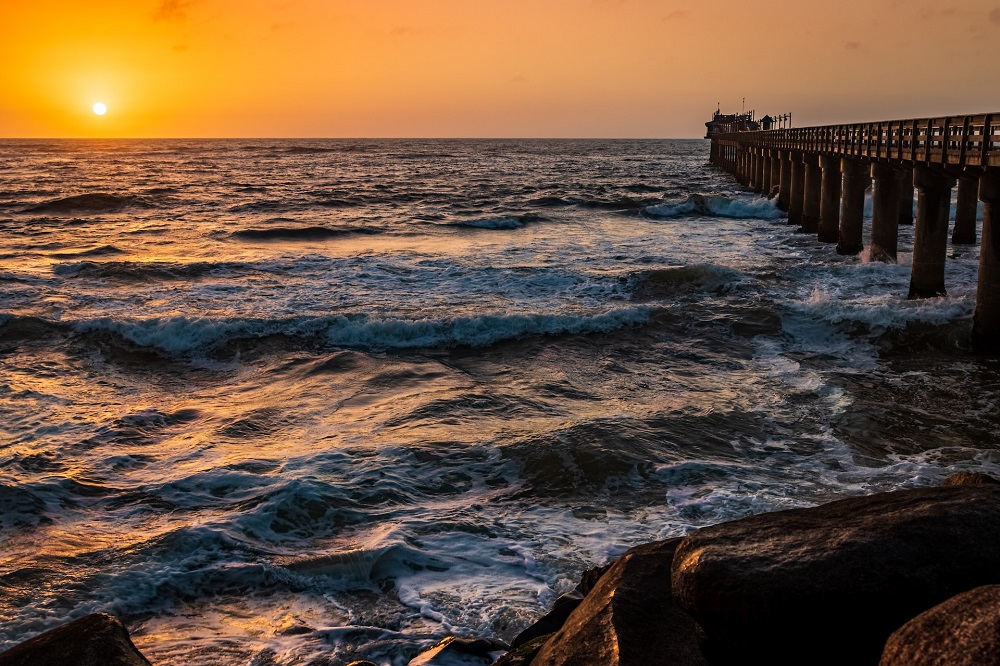
Swakopmund stopover
Swakopmund provides a refreshing change of pace on any Namibia trip. A popular Namibian summer beach resort for both locals and foreign visitors, Swakopmund is the place to take a breather from long drives and tight schedules. Walk out of the Strand Hotel right into the chilly water of the Atlantic which forms a breaker-free pool right alongside a jetty. You won’t be alone. Even in mid November, well before the start of the summer high season, there were almost always a few people on the beach. Swimming, playing volleyball or some other sport, or just hanging out with friends.
Walk in a different direction along the palm-fringed promenade and you’ll soon get to The Tug, a popular and reliably good seafood restaurant. Always a good choice? One of the linefish or catch of the day items. The local aquarium is currently closed for ‘major’ renovations and it is likely to be shuttered indefinitely.
An hour or so spent in the Swakopmund museum can be quite fascinating and educational. Its surprisingly diverse range of exhibits, topics and artifacts showcase the region’s rich cultural and natural history. Highlights include exhibits on the indigenous Topnaar people, displays of marine life, artifacts from colonial times and a diverse collection of minerals. The museum provides insight into Namibia’s unique heritage and ecosystems.
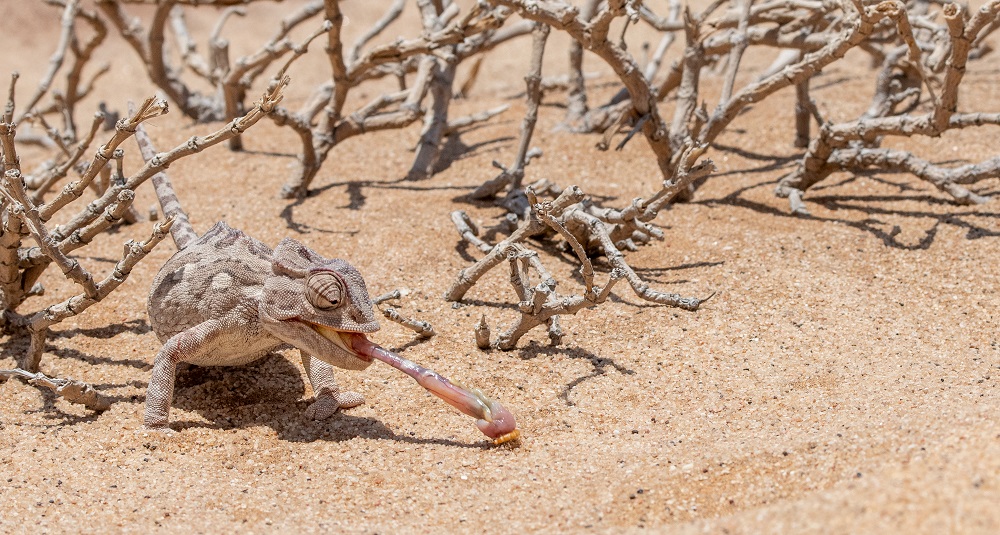
A morning outing into the dunes along the Swakop River with a guide from Batis Birding tours illustrates the remarkable adaptations of various animals which thrive in this bone dry desert environment which gets essentially zero rainfall. What moisture there is comes in the way of mostly nighttime fog which is ingeniously captured and utilized by several desert organisms.
Over the course of a short 2-hour morning outing, we encountered and were able to get some good photographs of the peculiar Namib dune gecko, Namaqua chameleon, shovel-snouted lizard, horned adder and Fitzsimmon’s burrowing skink.
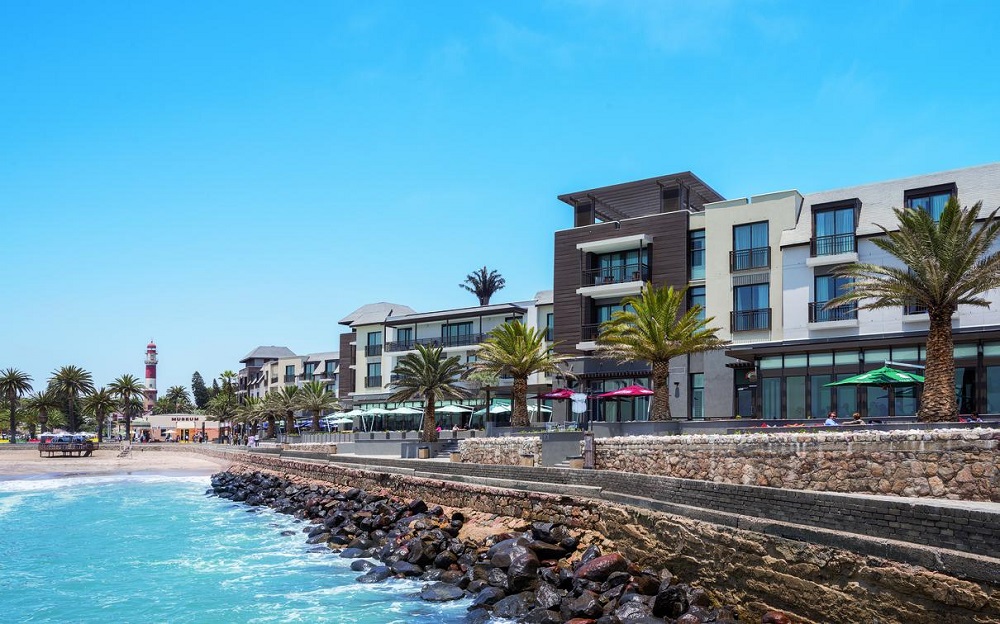
Strand Hotel, Swakopmund
Kathy and I had been planning to spend a night or two at the Strand Hotel since we walked by it on a previous visit. It was all about the location being right on the beach and seemingly ideally situated for a short walk into town. Which is the way it turned out to be. Add to that comfortable rooms with good lighting and a strong shower, and in our case – a view of the beach. The next morning we discovered the best reason to stay here. Breakfast. I can’t even begin to list the practically innumerable buffet and a la carte options at The Farmhouse Deli where breakfast is served. Get there early, it’s popular! Everything we tried was excellent. The two other Strand Hotel restaurants – Brewer & Butcher and Ocean Cellar – did not lag behind. The front office staff was unfailingly courteous and helpful. All around the hospitality was impeccable and we will definitely be using this property again.
Scenic flight Swakopmund to Sossusvlei
More than any other experience on our trip, the scenic flight from Swakopmund to Sossusvlei illustrated the immensity of the duneveld in south central Namibia. Our pilot from Swakopmund-based Scenic Air mentioned that it was the biggest expanse of tall dunes anywhere on planet Earth, rivaled only by the dunes of Mars. I believe it. The sight from the air is simply awesome. Hundreds of massive mounds of windblown red sand stretching out in every direction like so many pebbles on a beach. Incredible. And it can only be seen from the air.
While the visual of the duneveld was certainly the highlight of the flight, there were several other superb photo opportunities such as these:
- After taking off from Swakopmund in a Cessna 208 (Caravan) we flew past the Walvis Bay harbor, and then over the vividly colored salt pans just to its south.
- We viewed the famous Sandwich Harbor wetland heading a bit further south, past the Eduard Bohlen and Shawnee Shipwrecks.
- Leaving the coast and entering the “Sea of Dunes” took us past the long-deserted Charlottenfelder diamond camps.
- At Sossusvlei and Dead Vlei our pilot made a comfortable shallow turn around the area for a view of the pans among the 1,000-foot-tall sand dunes.

Sossusvlei dunes excursion
The massive red dunes at Sossusvlei attract a crowd pretty much every day of the year. They are also best photographed early, as soon as possible after first light. How to avoid the crowds and get to the dunes early? Stay inside the park and get to the dunes as close as possible to sunrise. Which was at 6:20 am in mid-November.
Driving in from outside the park – as we did from Ultimate’s Camp Sossus – was a fine experience overall but for someone intent on capturing the dunes at their most dramatic early morning moments, with sharply contrasting interplay of shadow and soft light, it doesn’t work very well.
By the time we made it to Dead Vlei it was just too late. Almost 8:00 am and the sun was way high in the sky. Plus there were already bunches of other vehicles in the parking lot, with more arriving every minute. Just too many people wandering around to get that quintessential ‘isolated tree in front of a sand dune’ shot.
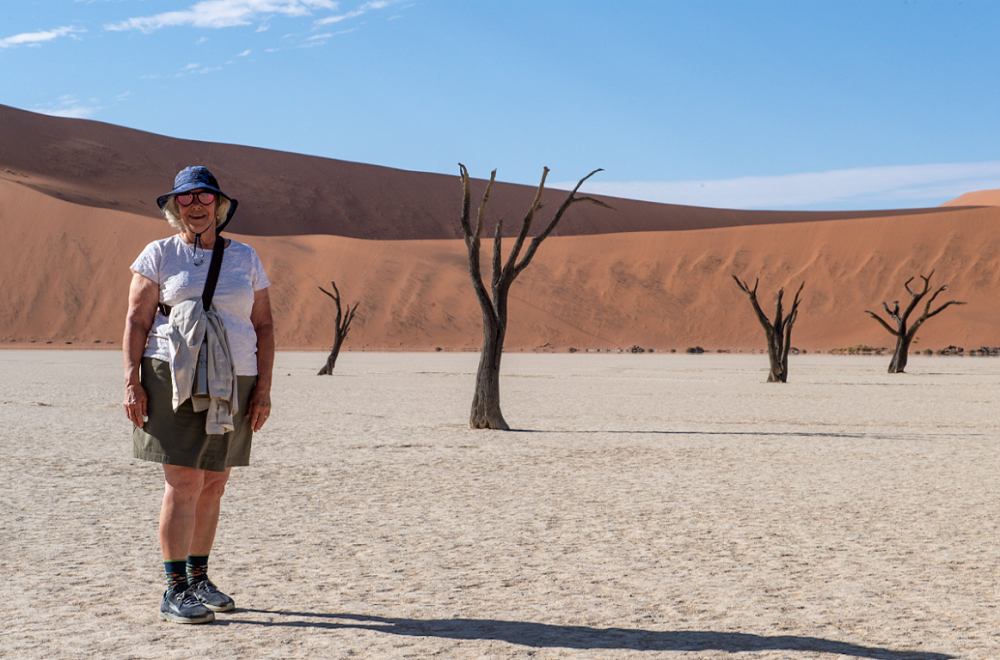
We made the best of the situation nonetheless and captured a few nice images of the white gravel plains, semi-fossilized black tree stumps, apricot-colored dunes and crisp blue sky.
It’s a 15-minute walk from the parking lot at Sossusvlei to Dead Vlei. Compared with earlier visits to the dunes just a few years ago, a considerable amount of sand has been blown over the trail. So come prepared with sturdy footwear. Flip flops? No. And take some water and sunscreen. The Namib sun is relentless and temperatures increase sharply from as early as 9 am.
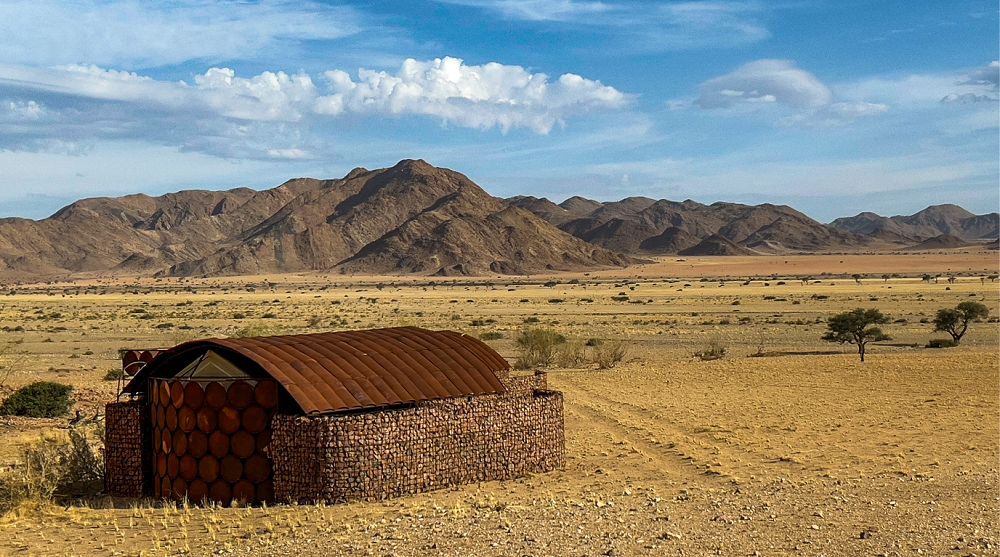
Camp Sossus
There’s a lot to like about this small hybrid tented camp which snuggles up to a rocky outcrop in the Namib Tsaris Conservancy. To the front of camp a vegetated plain stretches far into the distance with portions of the Nubib and Zaris Mountains to be seen. Particularly early in the morning and in the late afternoon, the beautiful desert light – often suffused with fine dust particles – impart a surreal painting-like quality to the scenery.
Beyond the location, Camp Sossus was as peaceful and serene a place as we had ever spent a couple of nights. A bonus was being able to sleep in the open under the stars, which several of our party took advantage of. With very little in the way of light pollution the sky above your bed is ablaze with the proverbial million stars. Sweet dreams.
The hybrid tented rooms are small with just enough room to fit two ¾ beds side by side, a tiny side table and an open space to hang a few garments. With an iron roof and cinder block casing, the tent was surprisingly cool and handled the desert heat admirably well. With a fan going it was just cool enough to doze off in the afternoon. Evenings were downright pleasant with the heat dissipating quickly as soon as the sun went down.
The small bathroom had a flush toilet, hand basin with cold water and an enclosed shower with a low pressure (bucket) shower. Hot water for the shower was available on demand. The shower head was inadequate with just not enough of a stream; perhaps it was clogged. The lighting in the room and bathroom was good except that there was no reading light.

The bottom line: Camp Sossus was a good choice to end our Namibia journey, representing of a lot of what makes the country special: the hauntingly beautiful scenery, the warm, friendly people and the sense of being away from it all in a relaxed, easy-going setting with few other people and vehicles around.
Our Fish Eagle Safaris team is ready to assist you with your own customized Namibia trip so please call or email us for further information, at 1 800 513-5222 (our office in Houston) or bert@fisheaglesafaris.com. We can also assist with scheduled small-group road trips in Namibia, along the lines of the trip on which this blog is based.


